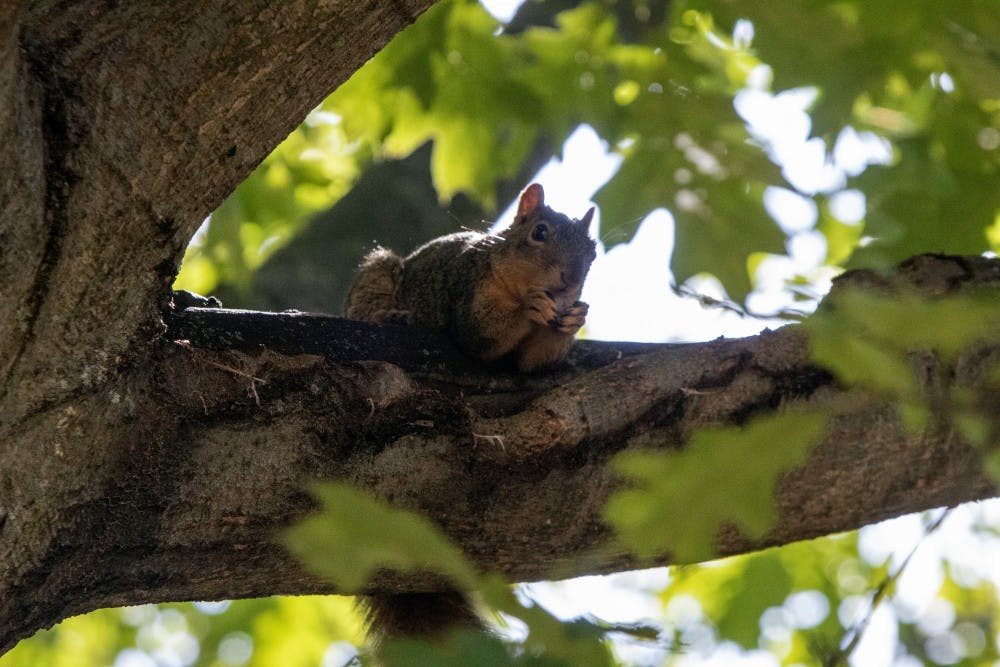When IU sophomore Justin Duckett came back to campus in August, he became concerned.
Duckett is the head administrator of the @squirrels_at_iu Instagram page, which chronicles the lives of squirrels on the IU-Bloomington campus. He said last April and May, he saw about 20 squirrels per day throughout campus.
When he came back to Bloomington, he had trouble spotting them.
“I was trying to see who was around, and I couldn’t find any of them,” he said.
In August and September, Duckett said he only saw about one squirrel every few days. He and other group members have since been able to find some of the squirrels near Dunn’s Woods. Now he said he sees about five or six squirrels per day.
Duckett said he knows how to identify the different on-campus squirrels, so he knows which ones he’s seen and hasn’t seen. Many squirrels have distinctive features, such as color, patterns or the shape of some body parts. The page, which has roughly 15,300 followers, has given some of the squirrels names, such as Bumpkin, Charlotte, Sampson, George and Huckleberry.
Duckett said it’s not just squirrels. He’s also noticed a decrease in rabbit, chipmunk and bird sightings.
Mike Girvin is the IU Facility Operations assistant director for landscape services. Before being employed at IU, he worked as a park naturalist in Cincinnati. He said he’s noticed less animals on campus this year compared to previous years, but he thinks the decline is natural.
“It’s not uncommon for population levels to cycle in and out over a multi-year period,” Girvin said.
He said the past few years have produced bountiful crops of nuts and other foods, so more squirrels and chipmunks have flocked to the area. However, predators such as coyotes, foxes and birds of prey have moved into the area to follow the creatures.
Girvin said for the past two years, he’s seen more hawks on campus than he had in the previous 10 years. He said raccoons and opossums will take young squirrels and chipmunks from their nests.
“They’re opportunists,” he said. “It’s survival of the fittest.”
Duckett said he was concerned about unleashed dogs threatening the squirrels. He said the Instagram page gets frequent messages reporting dogs being on the loose.
“As soon as squirrels sense any kind of danger, they’ll usually hightail it away,” he said. “Sometimes if that danger persists, they’ll just pack up and move away.”
Adam Fudickar is a research scientist at the IU Environmental Resilience Institute who studies animals in urban areas. He said in general, there’s less biodiversity and abundance of animals in areas that have high human influence.
“When you introduce us as a stressor in the environment, some species have shown they can cope with it, but some can’t,” Fudickar said.
Fudickar said human amenities such as artificial lights for public safety can disrupt animals, making it difficult for them to find dark areas of campus at night.
Duckett said new students coming back to campus for the fall semester could have disrupted the animals. The decline in squirrel sightings might also have to do with construction that happened over the summer.
“I feel like the noise and activity kind of chased them out of their normal areas,” Duckett said. “The time they were missing could have potentially been them getting acclimated to their new areas.”
Girvin said Facility Operations has a hands-off policy when it comes to wildlife.
“Most people working the grounds have an affinity for nature,” he said. “It’s part of the calling. We try to be sensitive to the world around us.”
Girvin said the only traps the office sets up on campus are for rats, which don’t work on squirrels and chipmunks.
The animals are used to the maintenance workers, he said.
“Our machines tend to be loud, so most things are pretty good about getting out of the way when they’re coming,” Girvin said.
Girvin said his department is responsible for cleaning up dead animals on campus, and many animals get run over by cars or electric scooters.
“I don’t think anyone purposely goes out with that intent,” Girvin said. “We just have a lot of moving things on campus that could run the animals over.”
Fudickar said IU has done a good job of providing large patches of wild areas where there is less human activity, such as Dunn’s Woods.
“I think that could help serve as a refuge for some animals,” he said.
Girvin said he thinks it’s too early to be concerned about the small mammal population on campus.
“I think it’s a natural cycle,” he said.
Duckett said campus wildlife should be protected.
“Campus is an ecosystem in itself,” he said. “It’s important that we maintain that.”




